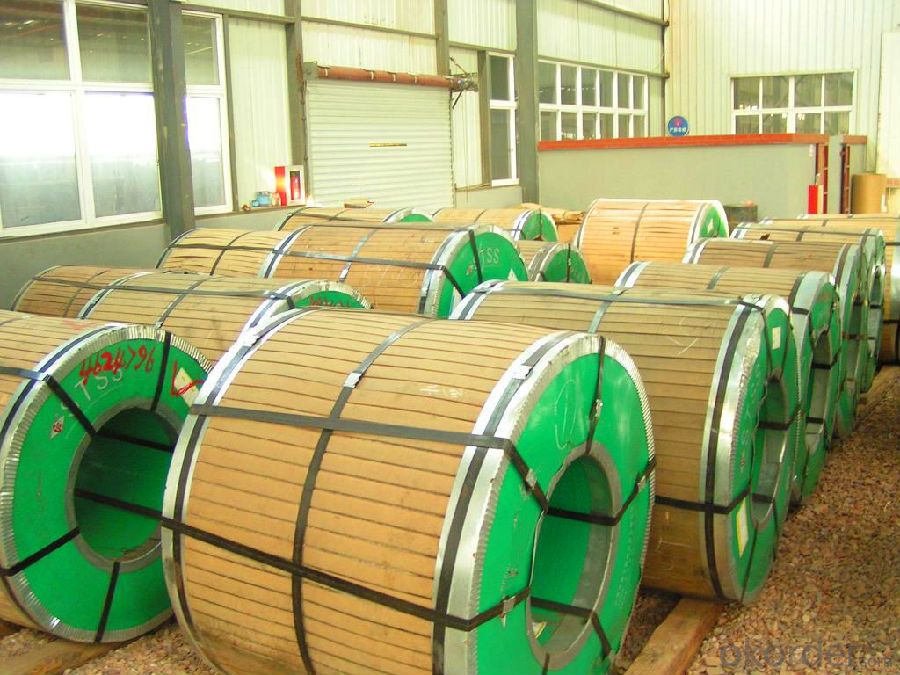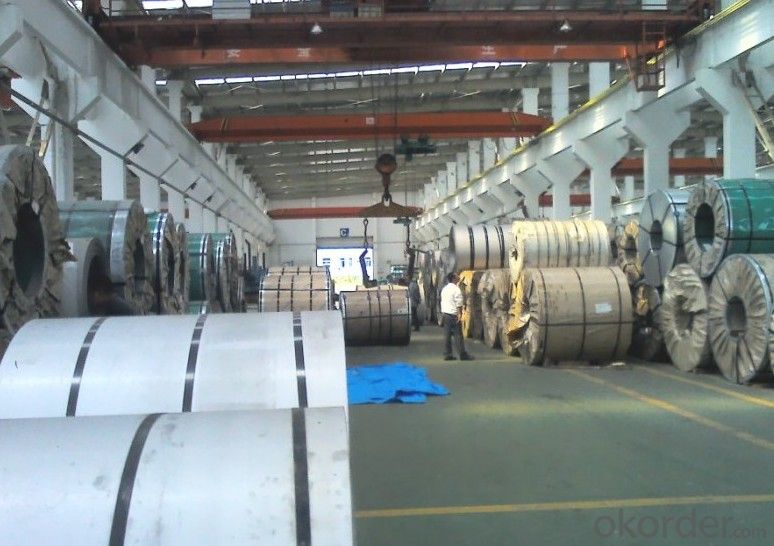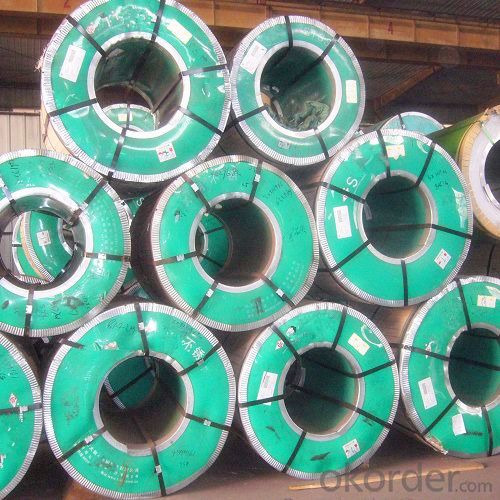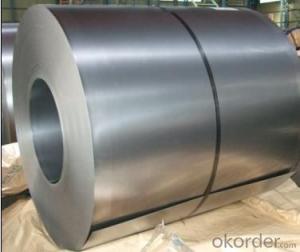Stainless Steel Coil 201 Hot Rolled Narrow Coil J2
- Loading Port:
- Lianyungang
- Payment Terms:
- TT OR LC
- Min Order Qty:
- 400 m.t.
- Supply Capability:
- 8000 m.t./month
OKorder Service Pledge
OKorder Financial Service
You Might Also Like
Hot Rolled Stainless Steel Coil
201 Narrow/Wide Strip No.1 Finish
Packaging Detail: For customer's requirement
Delivery Detail: 10-30days
201 Hot Rolled Stainless Steel Coil Specifications
THK:2.3/2.5/3.0/4.0mm
Width:485/510/550/610/1010/1240mm
Face:No.1
201 Hot rolled stainless steel Coil Application
Stainless steel is a production which not easy rust,acid resistance and corrosion resistance,so it is widely
used in light industry,heavy industry,daily necessities and the decoration industry.
201 Hot Stainless Steel Coil Chemical Composition(WT%)
(C):≤0.15, (Si):≤0.75, (Mn):5.5~7.50, (Cr):16.0~18.0, (N):≤0.25, (Ni):3.50~5.50, (P):≤0.060, (S):≤0.030
201 Hot Rolled Stainless Steel Coil
Strength Of Extension:100,000 To 180,000 Psi;
Yield Strength:50,000 To 150,000 Psi
Elongation :55 To 60%;
Modulus Of Elasticity:29,000,000 Psi;
Density :.280lbs/Cubic Inch(7.93g/Cm3)



- Q:What is the difference between annealed and tempered stainless steel strips?
- The main difference between annealed and tempered stainless steel strips lies in their mechanical properties. Annealed stainless steel strips are soft and ductile, making them easier to form and manipulate. On the other hand, tempered stainless steel strips undergo a heat treatment process that increases their strength and hardness, making them more resistant to wear, corrosion, and deformation.
- Q:Can stainless steel strips be used in marine applications?
- Indeed, the utilization of stainless steel strips in marine applications is possible. The exceptional corrosion resistance of stainless steel renders it a perfect choice for marine settings, where it endures constant exposure to saltwater and moisture. In marine applications, such as boat hardware, marine fittings, and structural components, stainless steel strips are frequently employed. These strips are specifically engineered to endure the rigorous conditions of the sea, including elevated levels of salt, humidity, and UV exposure. Moreover, stainless steel strips exhibit remarkable strength and durability, guaranteeing their ability to endure the challenging conditions of marine environments for an extended duration.
- Q:What are the common uses of stainless steel strips in the semiconductor industry?
- Due to their unique characteristics and properties, stainless steel strips find a multitude of applications in the semiconductor industry. Some of the key uses are as follows: 1. Semiconductor fabrication involves the use of stainless steel strips as etching masks. These strips possess resistance against different chemical etchants and provide excellent corrosion resistance. Consequently, they are perfect for safeguarding specific areas of the semiconductor surface during the etching process. 2. Throughout the manufacturing process, stainless steel strips are employed for handling delicate silicon wafers. By offering a clean and contamination-free surface, the strips prevent any harm or contamination that could compromise the quality of the wafers. 3. In the construction of cleanrooms within the semiconductor industry, stainless steel strips are commonly utilized. The preference for these strips stems from their high resistance to corrosion, durability, and ability to withstand the harsh cleaning chemicals used in cleanroom maintenance. 4. To prevent damage to sensitive semiconductor components caused by electrostatic discharge (ESD), stainless steel strips function as grounding strips or ESD protection strips. These strips dissipate any static charges, thereby safeguarding the semiconductor devices during the assembly and testing processes. 5. Stainless steel strips are employed in the creation of heat exchangers that regulate temperature during different semiconductor manufacturing processes. The strips' exceptional thermal conductivity and corrosion resistance enable efficient heat transfer while maintaining a clean and sterile environment. 6. The surface mount technology (SMT) process involves the direct mounting of electronic components onto the surface of a printed circuit board. In this process, stainless steel strips serve as solder stencils, enabling the precise application of solder paste onto the board and ensuring accurate component placement during assembly. Overall, stainless steel strips are highly valued in the semiconductor industry due to their corrosion resistance, cleanliness, durability, and ability to withstand extreme conditions. As a result, they play an indispensable role in various stages of semiconductor manufacturing.
- Q:How do you determine the corrosion resistance of a stainless steel strip?
- To determine the corrosion resistance of a stainless steel strip, several methods can be employed. One common technique is conducting a corrosion test, such as the salt spray test or the immersion test. In the salt spray test, the stainless steel strip is exposed to a saline solution, typically composed of sodium chloride, in a controlled environment. The strip is placed in a chamber where it is subjected to a continuous mist of the saline solution. The duration of the test can vary depending on the desired evaluation period, but it is often conducted for a minimum of 24 hours. After the test, the strip is inspected for any signs of corrosion, such as rust or pitting. The extent and severity of the corrosion can then be evaluated to determine the strip's corrosion resistance. Another method is the immersion test, where the stainless steel strip is submerged in a corrosive solution for a specific period. The solution used in this test can be tailored to simulate the specific corrosive environment the strip is expected to encounter in its intended application. Again, after the immersion period, the strip is examined for any signs of corrosion. Furthermore, electrochemical techniques can be employed to assess the corrosion resistance of a stainless steel strip. One such technique is the potentiodynamic polarization test, which involves subjecting the strip to a range of electrical potentials while monitoring the current flow. The resulting polarization curve can provide insights into the corrosion behavior of the strip, including its corrosion potential and corrosion rate. It is important to note that these tests should be conducted in accordance with relevant industry standards, such as ASTM (American Society for Testing and Materials) or ISO (International Organization for Standardization) specifications, to ensure accurate and consistent evaluation of the stainless steel strip's corrosion resistance. Additionally, it is essential to consider the specific alloy composition, surface finish, and any other factors that may influence the corrosion resistance of the strip when performing these tests.
- Q:Can 111 stainless steel strips be used in the chemical processing industry?
- In the chemical processing industry, it is possible to utilize 111 stainless steel strips. These stainless steel strips belong to the 300 series, which is renowned for its exceptional resistance to corrosion. Consequently, they are well-suited for environments with high chemical levels and corrosive substances. Moreover, 111 stainless steel strips possess commendable strength, toughness, and formability, rendering them suitable for a variety of applications in the chemical processing industry, including tanks, pipes, valves, and other equipment. Nevertheless, it is crucial to consider the particular requirements and conditions of a given chemical processing operation to ensure that 111 stainless steel is both compatible and appropriate for the specific application.
- Q:Can stainless steel strips be used in defense applications?
- Yes, stainless steel strips can be used in defense applications. Stainless steel is known for its durability, corrosion resistance, and strength, making it suitable for various defense purposes such as armor plating, weapon components, and military vehicles. Its ability to withstand harsh environments and resist impact makes it a reliable choice in defense applications.
- Q:Can stainless steel strips be used for jewelry findings?
- Yes, stainless steel strips can be used for jewelry findings. Stainless steel is a durable and corrosion-resistant material, making it suitable for various jewelry components such as clasps, jump rings, and connectors. Its strength and versatility make it a popular choice among jewelry designers.
- Q:Can stainless steel strips be used in pressure vessels?
- Yes, stainless steel strips can be used in pressure vessels. Stainless steel is known for its excellent resistance to corrosion, high strength, and ability to withstand high pressure conditions. It is commonly used in various industries including oil and gas, chemical processing, and food and beverage. Stainless steel strips can be fabricated and formed into the desired shape to meet the specific requirements of pressure vessel applications.
- Q:How is corrosion resistance achieved in stainless steel strips?
- The ability of stainless steel strips to resist corrosion is achieved through a combination of factors inherent to their composition and structure. The main factor responsible for corrosion resistance is chromium. By adding significant amounts of chromium to the steel alloy (typically at least 10.5%), a thin oxide layer is formed on the surface of the steel. This layer acts as a barrier, preventing further corrosion and protecting the underlying steel from corrosive elements. In addition to chromium, stainless steel also contains other alloying elements like nickel, molybdenum, and nitrogen, which further enhance its corrosion resistance. These elements help stabilize the oxide layer and improve resistance to specific types of corrosion. The microstructure of stainless steel also plays a crucial role in its corrosion resistance. It can exist in different crystal structures, such as austenitic, ferritic, martensitic, and duplex. The most common type used in stainless steel strips is austenitic stainless steel, which has a face-centered cubic structure. This structure provides excellent corrosion resistance and makes stainless steel strips suitable for various applications. Moreover, stainless steel strips can undergo different surface treatments to enhance their corrosion resistance. These treatments include passivation, pickling, and electropolishing, which remove impurities, contaminants, and free iron from the surface, promoting the formation of a more robust and protective oxide layer. Overall, the combination of alloying elements, oxide layer formation, microstructure, and surface treatments contribute to the remarkable corrosion resistance of stainless steel strips. This makes them highly durable and suitable for various environments and applications where corrosion is a concern.
- Q:How are 111 stainless steel strips manufactured?
- The manufacturing process for 111 stainless steel strips encompasses several stages. Initially, raw materials are carefully chosen, typically including iron ore, chromium, nickel, and other alloying elements. These materials are precisely measured and blended in the desired proportions to create the stainless steel alloy. Subsequently, the raw materials are melted in a high-temperature furnace. The resulting molten metal is then poured into a continuous casting machine, which shapes it into long slabs or billets. These slabs are allowed to cool and solidify. Once solidified, the slabs are reheated in a furnace to a specific temperature, rendering them more malleable. They are then passed through a hot rolling mill, where they are reduced in thickness and elongated into long strips. The rolling process is repeated multiple times until the desired thickness and quality are achieved. When the strips reach the desired thickness, they undergo annealing in a heat treatment furnace. Annealing helps alleviate internal stresses and enhance the mechanical properties of the stainless steel. This process involves heating the strips to a specific temperature and gradually cooling them. To improve the surface finish and eliminate imperfections, the strips are subjected to a pickling process. This entails immersing them in an acid solution that removes scale, oxides, and other impurities from the surface. Following pickling, the strips undergo a cold rolling process. This involves passing them through a series of high-pressure rollers, further reducing their thickness and enhancing their surface finish. To attain the desired dimensions and tolerances, the strips are subsequently cut into the required lengths using shearing or slitting machines. Depending on the specific application requirements, they may also undergo additional processes such as edge trimming, edge rounding, or surface polishing. Finally, the finished stainless steel strips undergo a thorough quality inspection, which includes checking for dimensional accuracy, surface defects, and mechanical properties. They are then carefully packaged and prepared for shipment to customers across various industries, such as automotive, construction, appliances, and many more.
1. Manufacturer Overview |
|
|---|---|
| Location | |
| Year Established | |
| Annual Output Value | |
| Main Markets | |
| Company Certifications | |
2. Manufacturer Certificates |
|
|---|---|
| a) Certification Name | |
| Range | |
| Reference | |
| Validity Period | |
3. Manufacturer Capability |
|
|---|---|
| a)Trade Capacity | |
| Nearest Port | |
| Export Percentage | |
| No.of Employees in Trade Department | |
| Language Spoken: | |
| b)Factory Information | |
| Factory Size: | |
| No. of Production Lines | |
| Contract Manufacturing | |
| Product Price Range | |
Send your message to us
Stainless Steel Coil 201 Hot Rolled Narrow Coil J2
- Loading Port:
- Lianyungang
- Payment Terms:
- TT OR LC
- Min Order Qty:
- 400 m.t.
- Supply Capability:
- 8000 m.t./month
OKorder Service Pledge
OKorder Financial Service
Similar products
New products
Hot products
Related keywords































